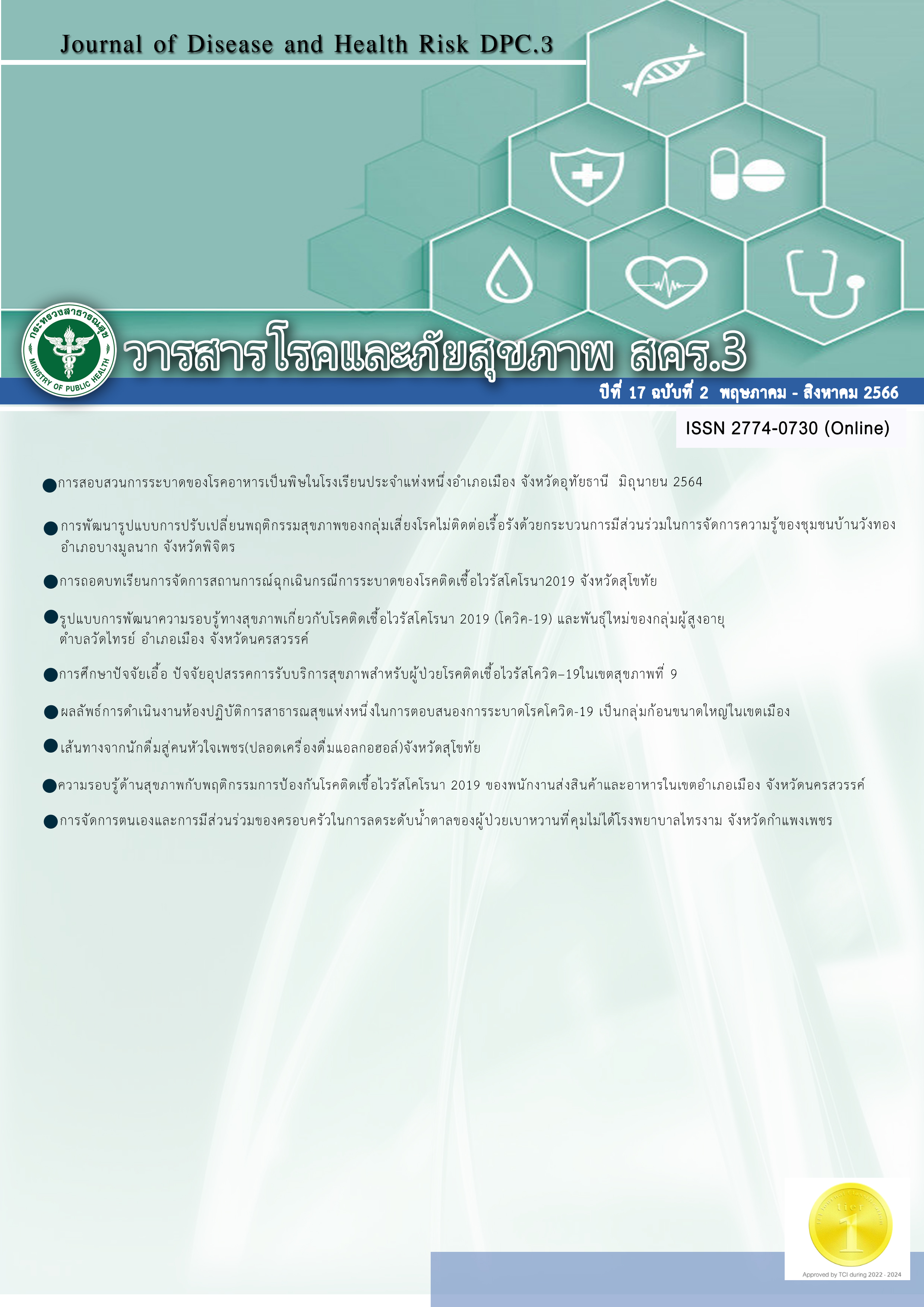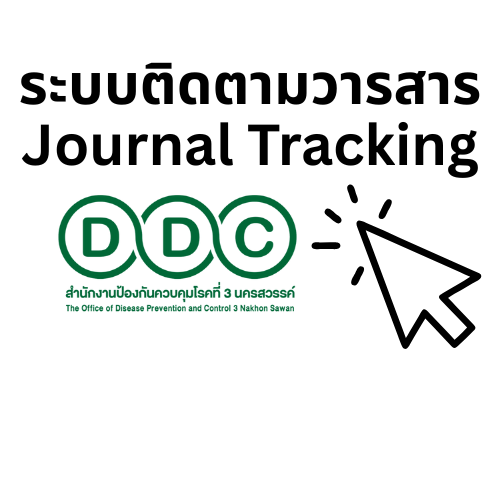The Development of Health Behavior Modification Model in Non-communicable Chronic Diseases Risk by Using Participatory Approach in Knowledge Management of the Community in Banwangthong Bangmulnak District, Phichit Province
Keywords:
Non-communicable diseases, Participation action, Health behavior modification modelAbstract
The two aims of this research were to develop a behavior change model for improving the health behaviors of the non-communicable disease (NCD) population at risk and to assess the effectiveness of the health behavior change intervention based on the PRECEDE Model. The research is conducted as an operational study, divided into qualitative research using tools such as interviews with 10 health behavior change leaders and a survey questionnaire administered to 40 individuals at-risk of participating in health behavior change activities. The qualitative data was analyzed by observing the involvement in knowledge management, including the contextual background, collaborative planning, implementation, and evaluation. The quantitative analysis involves a health status and health behavior survey, analyzed using descriptive statistics, paired t-tests for inferential statistics, and Pearson correlation analysis. The research findings indicate that: 1) the health behavior change model implemented in the Wang Thong community through knowledge management, community contextual study, and community stimulation had raised community awareness and potential for collaborative health behavior change; and 2) the health behavior change activities had resulted in improved self-efficacy, self-control, and health behaviors among the at-risk group, as well as reduced body mass index, waist circumference, and blood sugar levels, along with decreased blood pressure. The factors contributing to the success of the intervention depend on the participation of all stakeholders in community health care, the leadership capacity, and the team's involvement. Furthermore, policy development and health promotion are essential for accessing health promotion activities.
References
ประเวศ วะสี. สุขภาพในฐานะอุดมการณ์ของมนุษย์. พิมพ์ครั้งที่ 3. นนทบุรี; สำนักงานปฏิรูปสุขภาพ สถาบันวิจัยระบบสาธารณสุข; 2543.
สำนักโรคไม่ติดต่อ กรมควบคุมโรค กระทรวงสาธารณสุข. รายงานการประชุมเชิงปฏิบัติการ นโยบายสู่การปฏิบัติระบบเฝ้าระวังพฤติกรรม สุขภาพเสี่ยงโรคและภัยสุขภาพเพื่อการ ปรับเปลี่ยนพฤติกรรมเสี่ยงของกลุ่มปกติ/ เสี่ยง/ป่วย เบาหวาน ความดันโลหิตสูงและการ ป้องกัน ควบคุมโรคไข้เลือดออกในประเทศไทย. กรุงเทพฯ: ชุมนุมสหกรณ์การเกษตรแห่งประเทศไทย; 2556.
กลุ่มพัฒนาระบบสาธารณสุข กระทรวงสาธารณสุข. รายงานสถานการณ์โรค NCDs เบาหวาน ความดันโลหิตสูง และปัจจัยที่เกี่ยวข้อง พ.ศ. 2562, สำนักพิมพ์อักษรกราฟฟิคดีโซด์; 2563.
ปิยรัตน์ ชูมี. การศึกษาระดับความรู้ด้านโรคเรื้อรังและสมรรถนะในการให้บริการโรคเรื้อรังในชุมชนของอาสาสมัครสาธารณสุขประจำหมู่บ้าน จังหวัดสุราษฎร์ธานี. วารสารพยาบาลทหารบก. 2560; 21(1): 235-244.
สมาคมโรคเบาหวานแห่งประเทศไทย. แนวทางเวชปฏิบัติสำหรับโรคเบาหวาน พ.ศ. 2557. ศรีเมืองการพิมพ์. กรุงเทพฯ. 2557.
กองระบาดวิทยา. กองระบาดวิทยา กรมควบคุมโรค. พยากรณ์โรคและภัยสุขภาพรายสัปดาห์ ฉบับที่ 231 (วันที่ 13 - 19 ต.ค. 2562). 2562.
วชิรา โพธิ์ใส. ความรอบรู้ด้านสุขภาพจิตและคุณภาพชีวิตของผู้ป่วยโรคหลอดเลือดสมอง. เชียงใหม่เวชสาร. 2564; 60(1): 63-74.
สมศักดิ์ เทียมเก่า. พัฒนารูปแบบการดูแลผู้ป่วยโรคหลอดเลือดสมองที่นำไปปฏิบัติได้จริงในโรงพยาบาลทุกระดับ. สถาบันวิจัยระบบสาธารณสุข; 2562.
สำนักนโยบายและยุทธศาสตร์ สำนักงานปลัดกระทรวงสาธารณสุข. แผนยุทธศาสตร์สุขภาพดี วิถีไทย พ.ศ.2554-2563. พิมพ์ครั้งที่ 4. กรุงเทพฯ: สำนักพระพุทธศาสนาแห่งชาติ. 2554.
สำนักควบคุมโรคไม่ติดต่อ. กรมควบคุมโรค กระทรวงสาธารณสุข. รายงานสรุปข้อมูลการประชุมเชิงปฏิบัติการจัดทำข้อมูลโรคไม่ติดต่อระดับประเทศในการประชุม. กรุงเทพฯ: โอ-วิทย์, 2555.
โกมาตร จึงเสถียรทรัพย์. สุขภาพไทยวัฒนธรรมไทย. นนทบุรี: สํานักวิจัยสังคมและสุขภาพ; 2550.
สุธาทิพย์ จันทรักษ์. วารสารวิชาการกรมสนับสนุนบริการสุขภาพ. 2562; 13(2): 67-74.
สำนักงานสาธารณสุขอำเภอบางมูลนาก. รายงานการควบคุมโรคไม่ติดต่อเรื้อรังอำเภอบางมูลนาก พิจิตร ปี 2564. 2564.
โรงพยาบาลส่งเสริมสุขภาพตำบลบ้านวังทอง. รายงานข้อมูลการคัดกรองกลุ่มเสี่ยงด้านสุขภาพ ปี 2564 พิจิตร. 2564.
นรลักขณ์ เอื้อกิจ, ลัดดาวัลย์ เพ็ญศรี. การประยุกต์ใช้แนวคิด PRECEDE MODEL ในการสร้างเสริมสุขภาพ Utilization of the PRECEDE MODEL in Health Promotion: วารสารพยาบาลสภากาชาดไทย.2562; 12(1): 38-48.
พวงผกา สุวิสุวรรณ. รูปแบบการเสริมสร้างพฤติกรรมสุขภาพในกลุ่มเสี่ยงโรคเบาหวาน และโรคความดันโลหิตสูง ด้วยกระบวนการจัดการความรู้จังหวัดลำพูนวารสารวิชาการกรมสนับสนุนบริการสุขภาพ. 2564; 17(2): 41-50.
เวธกา กลิ่นวิชิต, พิสิษฐ์ พิริยาพรรณ, สรร กลิ่นวิชิต, พวงทอง อินใจ, คนึงนิจ อุสิมาศ,พลอยพันธุ์ กลิ่นวิชิต. การพัฒนาแกนนำสุขภาพครอบครัวและชุมชนเพื่อการดูแลผู้สูงอายุเทศบาลเมืองแสนสุข จังหวัดชลบุรี ปีที่ 2 [อินเทอร์เน็ต]. [สืบค้นเมื่อวันที่ 2 มีนาคม 2565]. แหล่งข้อมูล: http://dspace.lib.buu.ac.th/xmlui/handle/1234567890/1912.
นวรัตน์ โกมลวิภาต, วิลาวัลย์ อุดมการณ์. เกษตรประสิทธิผลของโปรแกรมส่งเสริมการรับรู้ความสามารถในตนเอง ต่อพฤติกรรมสุขภาพ น้ำ หนัก และเส้นรอบเอว ของนักศึกษาพยาบาลที่มีภาวะโภชนาการเกิน: วารสารสุขภาพภาคประชาชน. 2560; 37(2): 118-131.
นฤมล เพิ่มพูน และคณะ. ผลของโปรแกรมการปรับเปลี่ยนพฤติกรรมต่อพฤติกรรมสุขภาพและภาวะ
โภชนาการของพนักงานในสถานประกอบการที่มีภาวะน้าหนักเกินมาตรฐาน: วารสารโรงพยาบาลรามาธิบดี.2560; 22(2): 177-191.
ศิลป์ชัย เนตรทานนท์, อุทัยวรรณ โคกตาทอง. รูปแบบการส่งเสริมสุขภาพวัยทำงานในชุมชน เขตสุขภาพ ที่ 5: วารสารสุขภาพภาคประชาชน. 2564; 16(2): 8-22.
โสภาพันธ์ สะอาด. ผลของโปรแกรมการปรับเปลี่ยนพฤติกรรมต่อพฤติกรรมสุขภาพและภาวะโภชนาการของพนักงานในสถานประกอบการที่มีภาวะน้ำหนักเกินมาตรฐาน. วารสารวิทยบริการ: มหาวิทยาลัยสงขลานครินทร์. 2558; 26(2): 41-49.
Downloads
Published
How to Cite
Issue
Section
License
Copyright (c) 2023 Journal of Disease and Health Risk DPC.3

This work is licensed under a Creative Commons Attribution-NonCommercial-NoDerivatives 4.0 International License.
Copyright notice
Article published in the Journal of Disease and Health Risk DPC.3 Nakhon Sawan. It is considered a work of academic research and analysis as well as the personal opinion of the author. It is not the opinion of the Office of Disease Prevention and Control 3, Nakhon Sawan. Or the editorial team in any way Authors are responsible for their articles.
Privacy Policy
Name, address and e-mail address specified in the Journal of Disease and Health Risk DPC.3 Nakhon Sawan. It is used for identification purposes of the journal. And will not be used for any other purpose. Or to another person.









